Legal and Professional Issues in Nursing: A Palliative Care Case Study
VerifiedAdded on 2021/04/21
|8
|2194
|62
Report
AI Summary
This report examines the legal and professional challenges faced by nurses in palliative care, using the case of Tom, an Aboriginal patient. The report highlights the complexities of balancing patient autonomy, cultural considerations, and legal frameworks, especially when family members have differing opinions on treatment. It addresses the conflict arising from a daughter's legal authority versus the patient's wishes for palliative care, considering the impact of Aboriginal culture on decision-making. The report explores clinical issues like informed consent and the principles of beneficence and non-maleficence. It also discusses the goals of palliative care, including pain management, symptom alleviation, and spiritual well-being, emphasizing the importance of communication and shared decision-making with the family. The report suggests a course of action that involves establishing open communication, involving the family in the care plan, and respecting the patient's wishes while adhering to professional nursing standards. It concludes by emphasizing the need for a holistic approach to patient care, considering cultural, ethical, and legal dimensions to ensure the patient's comfort and dignity during end-of-life care. The report utilizes references from various academic sources to support its arguments and findings.
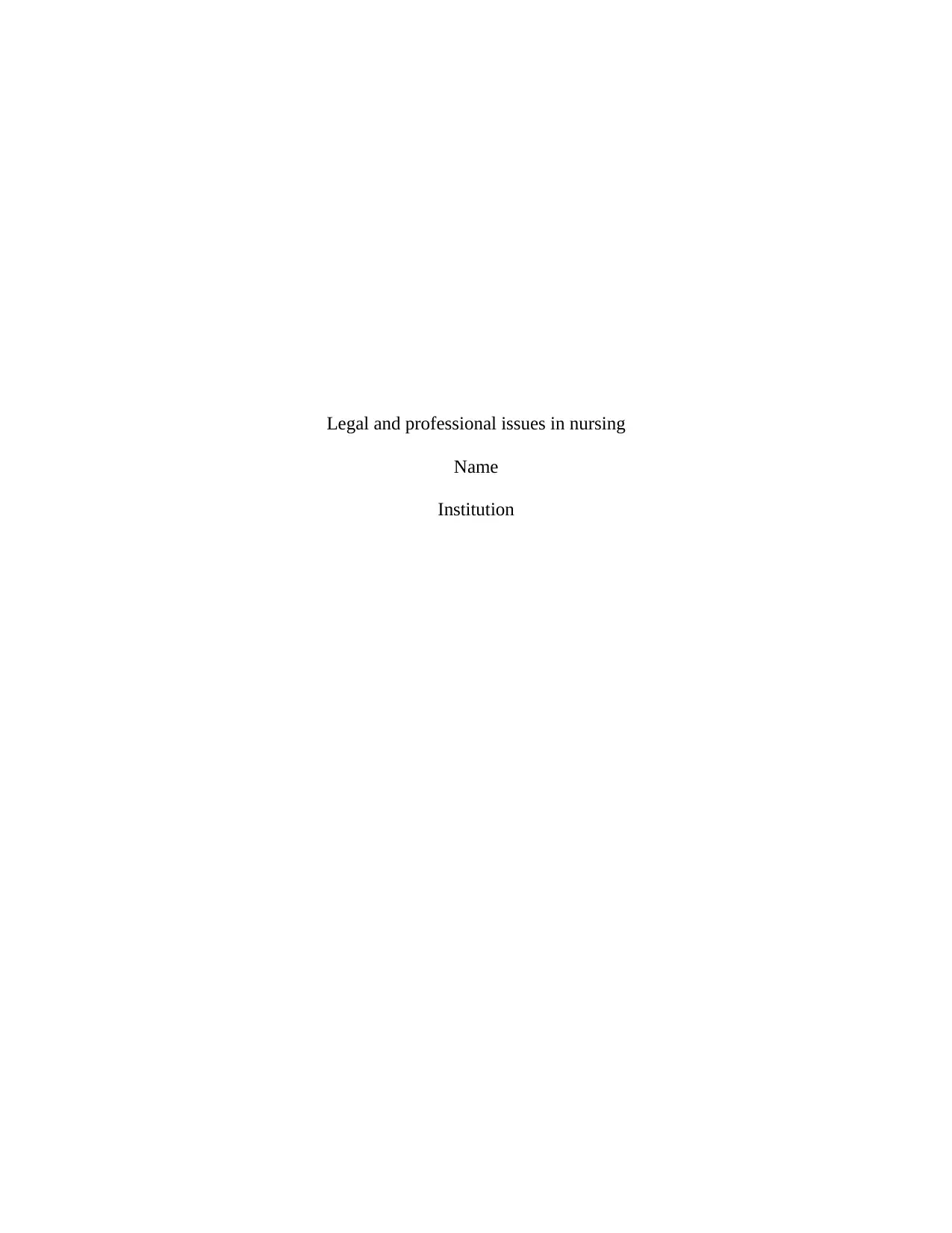
Legal and professional issues in nursing
Name
Institution
Name
Institution
Paraphrase This Document
Need a fresh take? Get an instant paraphrase of this document with our AI Paraphraser
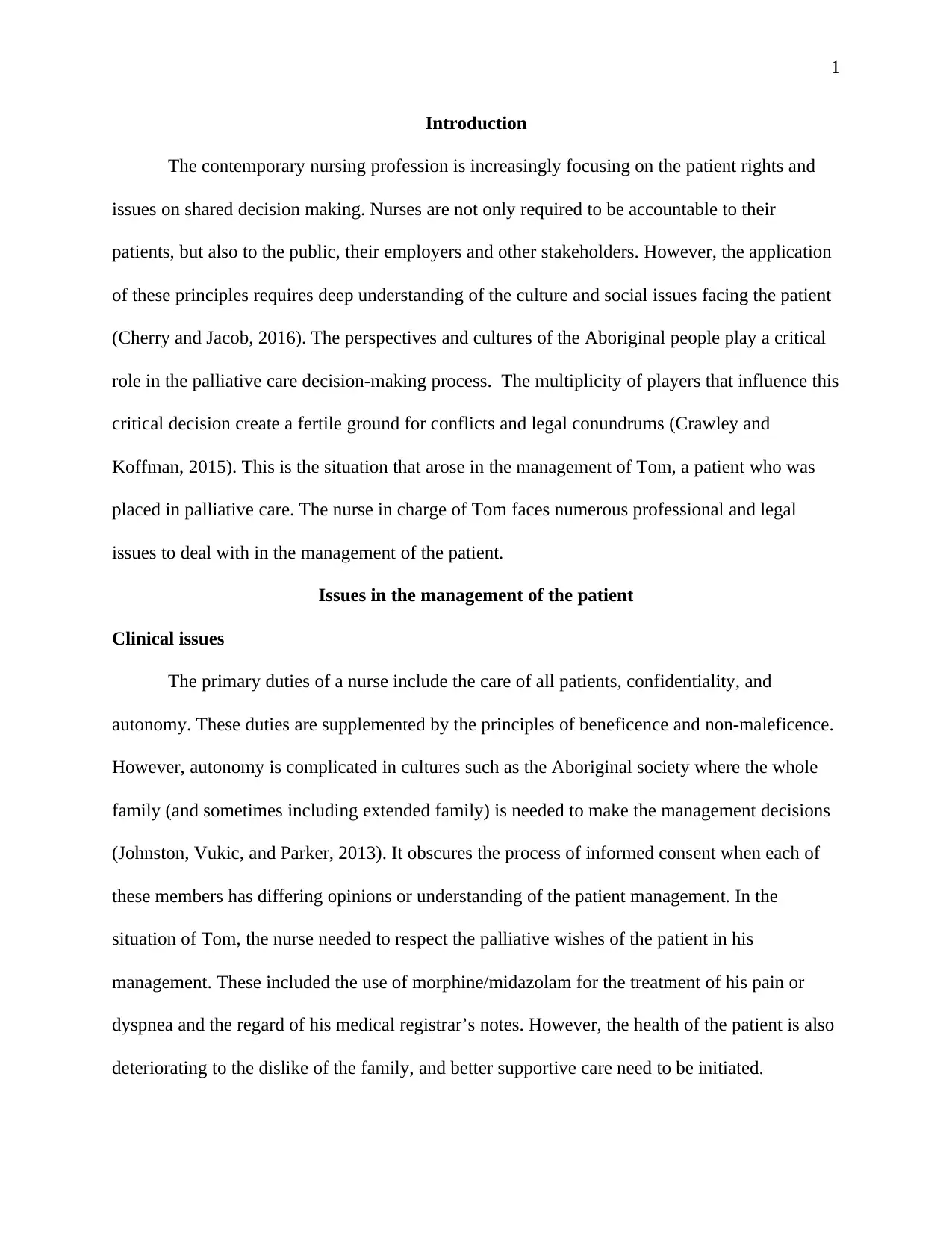
1
Introduction
The contemporary nursing profession is increasingly focusing on the patient rights and
issues on shared decision making. Nurses are not only required to be accountable to their
patients, but also to the public, their employers and other stakeholders. However, the application
of these principles requires deep understanding of the culture and social issues facing the patient
(Cherry and Jacob, 2016). The perspectives and cultures of the Aboriginal people play a critical
role in the palliative care decision-making process. The multiplicity of players that influence this
critical decision create a fertile ground for conflicts and legal conundrums (Crawley and
Koffman, 2015). This is the situation that arose in the management of Tom, a patient who was
placed in palliative care. The nurse in charge of Tom faces numerous professional and legal
issues to deal with in the management of the patient.
Issues in the management of the patient
Clinical issues
The primary duties of a nurse include the care of all patients, confidentiality, and
autonomy. These duties are supplemented by the principles of beneficence and non-maleficence.
However, autonomy is complicated in cultures such as the Aboriginal society where the whole
family (and sometimes including extended family) is needed to make the management decisions
(Johnston, Vukic, and Parker, 2013). It obscures the process of informed consent when each of
these members has differing opinions or understanding of the patient management. In the
situation of Tom, the nurse needed to respect the palliative wishes of the patient in his
management. These included the use of morphine/midazolam for the treatment of his pain or
dyspnea and the regard of his medical registrar’s notes. However, the health of the patient is also
deteriorating to the dislike of the family, and better supportive care need to be initiated.
Introduction
The contemporary nursing profession is increasingly focusing on the patient rights and
issues on shared decision making. Nurses are not only required to be accountable to their
patients, but also to the public, their employers and other stakeholders. However, the application
of these principles requires deep understanding of the culture and social issues facing the patient
(Cherry and Jacob, 2016). The perspectives and cultures of the Aboriginal people play a critical
role in the palliative care decision-making process. The multiplicity of players that influence this
critical decision create a fertile ground for conflicts and legal conundrums (Crawley and
Koffman, 2015). This is the situation that arose in the management of Tom, a patient who was
placed in palliative care. The nurse in charge of Tom faces numerous professional and legal
issues to deal with in the management of the patient.
Issues in the management of the patient
Clinical issues
The primary duties of a nurse include the care of all patients, confidentiality, and
autonomy. These duties are supplemented by the principles of beneficence and non-maleficence.
However, autonomy is complicated in cultures such as the Aboriginal society where the whole
family (and sometimes including extended family) is needed to make the management decisions
(Johnston, Vukic, and Parker, 2013). It obscures the process of informed consent when each of
these members has differing opinions or understanding of the patient management. In the
situation of Tom, the nurse needed to respect the palliative wishes of the patient in his
management. These included the use of morphine/midazolam for the treatment of his pain or
dyspnea and the regard of his medical registrar’s notes. However, the health of the patient is also
deteriorating to the dislike of the family, and better supportive care need to be initiated.
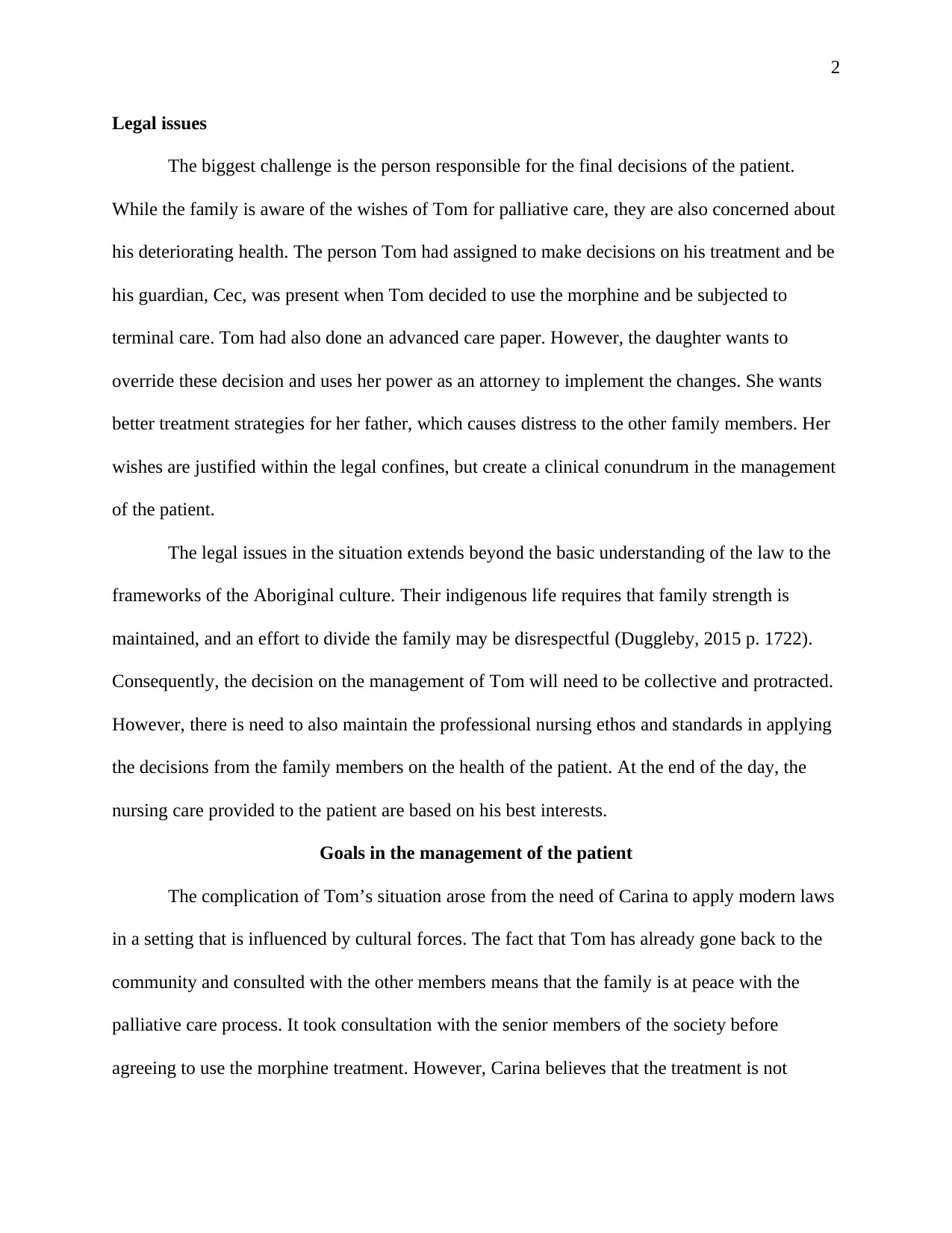
2
Legal issues
The biggest challenge is the person responsible for the final decisions of the patient.
While the family is aware of the wishes of Tom for palliative care, they are also concerned about
his deteriorating health. The person Tom had assigned to make decisions on his treatment and be
his guardian, Cec, was present when Tom decided to use the morphine and be subjected to
terminal care. Tom had also done an advanced care paper. However, the daughter wants to
override these decision and uses her power as an attorney to implement the changes. She wants
better treatment strategies for her father, which causes distress to the other family members. Her
wishes are justified within the legal confines, but create a clinical conundrum in the management
of the patient.
The legal issues in the situation extends beyond the basic understanding of the law to the
frameworks of the Aboriginal culture. Their indigenous life requires that family strength is
maintained, and an effort to divide the family may be disrespectful (Duggleby, 2015 p. 1722).
Consequently, the decision on the management of Tom will need to be collective and protracted.
However, there is need to also maintain the professional nursing ethos and standards in applying
the decisions from the family members on the health of the patient. At the end of the day, the
nursing care provided to the patient are based on his best interests.
Goals in the management of the patient
The complication of Tom’s situation arose from the need of Carina to apply modern laws
in a setting that is influenced by cultural forces. The fact that Tom has already gone back to the
community and consulted with the other members means that the family is at peace with the
palliative care process. It took consultation with the senior members of the society before
agreeing to use the morphine treatment. However, Carina believes that the treatment is not
Legal issues
The biggest challenge is the person responsible for the final decisions of the patient.
While the family is aware of the wishes of Tom for palliative care, they are also concerned about
his deteriorating health. The person Tom had assigned to make decisions on his treatment and be
his guardian, Cec, was present when Tom decided to use the morphine and be subjected to
terminal care. Tom had also done an advanced care paper. However, the daughter wants to
override these decision and uses her power as an attorney to implement the changes. She wants
better treatment strategies for her father, which causes distress to the other family members. Her
wishes are justified within the legal confines, but create a clinical conundrum in the management
of the patient.
The legal issues in the situation extends beyond the basic understanding of the law to the
frameworks of the Aboriginal culture. Their indigenous life requires that family strength is
maintained, and an effort to divide the family may be disrespectful (Duggleby, 2015 p. 1722).
Consequently, the decision on the management of Tom will need to be collective and protracted.
However, there is need to also maintain the professional nursing ethos and standards in applying
the decisions from the family members on the health of the patient. At the end of the day, the
nursing care provided to the patient are based on his best interests.
Goals in the management of the patient
The complication of Tom’s situation arose from the need of Carina to apply modern laws
in a setting that is influenced by cultural forces. The fact that Tom has already gone back to the
community and consulted with the other members means that the family is at peace with the
palliative care process. It took consultation with the senior members of the society before
agreeing to use the morphine treatment. However, Carina believes that the treatment is not
⊘ This is a preview!⊘
Do you want full access?
Subscribe today to unlock all pages.

Trusted by 1+ million students worldwide
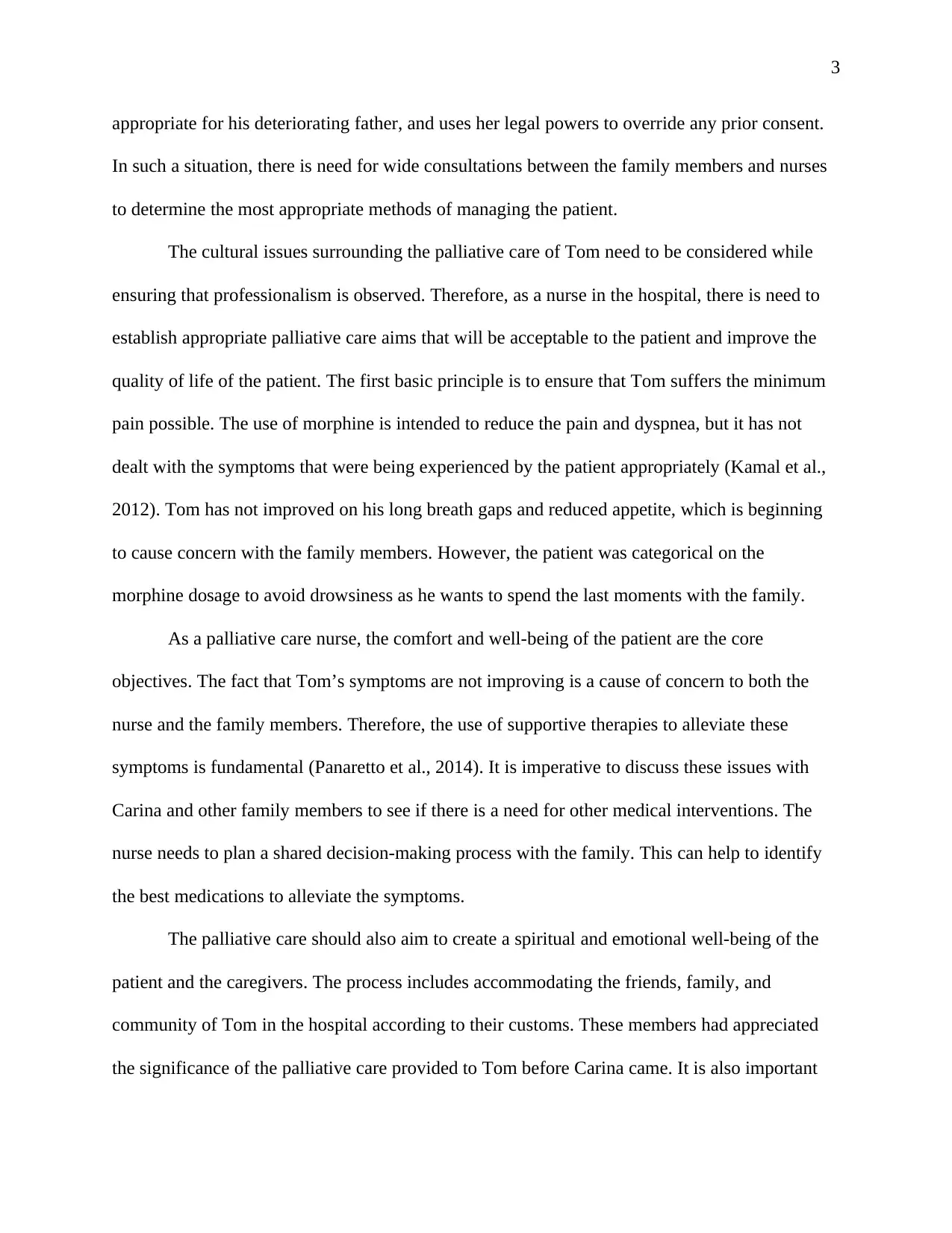
3
appropriate for his deteriorating father, and uses her legal powers to override any prior consent.
In such a situation, there is need for wide consultations between the family members and nurses
to determine the most appropriate methods of managing the patient.
The cultural issues surrounding the palliative care of Tom need to be considered while
ensuring that professionalism is observed. Therefore, as a nurse in the hospital, there is need to
establish appropriate palliative care aims that will be acceptable to the patient and improve the
quality of life of the patient. The first basic principle is to ensure that Tom suffers the minimum
pain possible. The use of morphine is intended to reduce the pain and dyspnea, but it has not
dealt with the symptoms that were being experienced by the patient appropriately (Kamal et al.,
2012). Tom has not improved on his long breath gaps and reduced appetite, which is beginning
to cause concern with the family members. However, the patient was categorical on the
morphine dosage to avoid drowsiness as he wants to spend the last moments with the family.
As a palliative care nurse, the comfort and well-being of the patient are the core
objectives. The fact that Tom’s symptoms are not improving is a cause of concern to both the
nurse and the family members. Therefore, the use of supportive therapies to alleviate these
symptoms is fundamental (Panaretto et al., 2014). It is imperative to discuss these issues with
Carina and other family members to see if there is a need for other medical interventions. The
nurse needs to plan a shared decision-making process with the family. This can help to identify
the best medications to alleviate the symptoms.
The palliative care should also aim to create a spiritual and emotional well-being of the
patient and the caregivers. The process includes accommodating the friends, family, and
community of Tom in the hospital according to their customs. These members had appreciated
the significance of the palliative care provided to Tom before Carina came. It is also important
appropriate for his deteriorating father, and uses her legal powers to override any prior consent.
In such a situation, there is need for wide consultations between the family members and nurses
to determine the most appropriate methods of managing the patient.
The cultural issues surrounding the palliative care of Tom need to be considered while
ensuring that professionalism is observed. Therefore, as a nurse in the hospital, there is need to
establish appropriate palliative care aims that will be acceptable to the patient and improve the
quality of life of the patient. The first basic principle is to ensure that Tom suffers the minimum
pain possible. The use of morphine is intended to reduce the pain and dyspnea, but it has not
dealt with the symptoms that were being experienced by the patient appropriately (Kamal et al.,
2012). Tom has not improved on his long breath gaps and reduced appetite, which is beginning
to cause concern with the family members. However, the patient was categorical on the
morphine dosage to avoid drowsiness as he wants to spend the last moments with the family.
As a palliative care nurse, the comfort and well-being of the patient are the core
objectives. The fact that Tom’s symptoms are not improving is a cause of concern to both the
nurse and the family members. Therefore, the use of supportive therapies to alleviate these
symptoms is fundamental (Panaretto et al., 2014). It is imperative to discuss these issues with
Carina and other family members to see if there is a need for other medical interventions. The
nurse needs to plan a shared decision-making process with the family. This can help to identify
the best medications to alleviate the symptoms.
The palliative care should also aim to create a spiritual and emotional well-being of the
patient and the caregivers. The process includes accommodating the friends, family, and
community of Tom in the hospital according to their customs. These members had appreciated
the significance of the palliative care provided to Tom before Carina came. It is also important
Paraphrase This Document
Need a fresh take? Get an instant paraphrase of this document with our AI Paraphraser
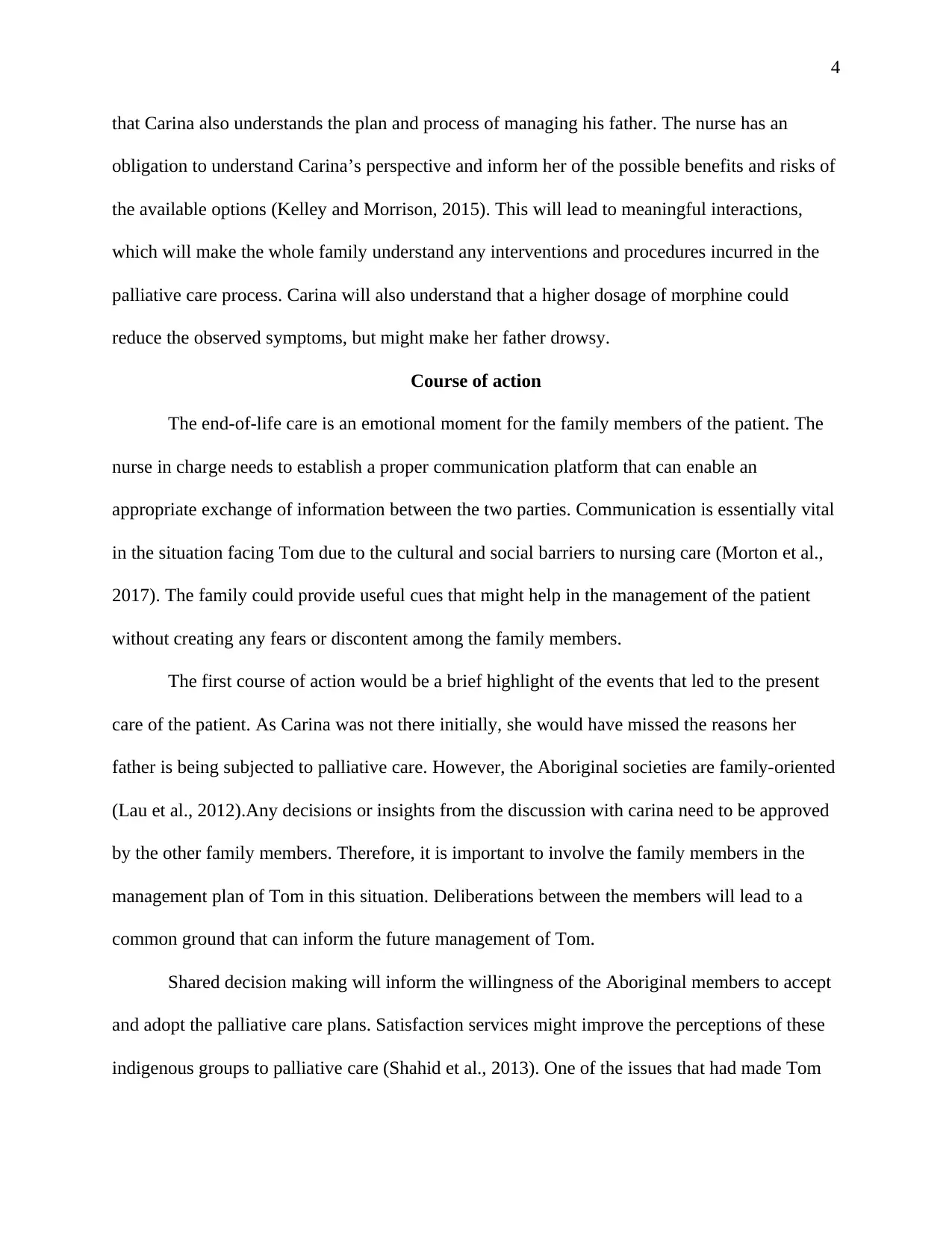
4
that Carina also understands the plan and process of managing his father. The nurse has an
obligation to understand Carina’s perspective and inform her of the possible benefits and risks of
the available options (Kelley and Morrison, 2015). This will lead to meaningful interactions,
which will make the whole family understand any interventions and procedures incurred in the
palliative care process. Carina will also understand that a higher dosage of morphine could
reduce the observed symptoms, but might make her father drowsy.
Course of action
The end-of-life care is an emotional moment for the family members of the patient. The
nurse in charge needs to establish a proper communication platform that can enable an
appropriate exchange of information between the two parties. Communication is essentially vital
in the situation facing Tom due to the cultural and social barriers to nursing care (Morton et al.,
2017). The family could provide useful cues that might help in the management of the patient
without creating any fears or discontent among the family members.
The first course of action would be a brief highlight of the events that led to the present
care of the patient. As Carina was not there initially, she would have missed the reasons her
father is being subjected to palliative care. However, the Aboriginal societies are family-oriented
(Lau et al., 2012).Any decisions or insights from the discussion with carina need to be approved
by the other family members. Therefore, it is important to involve the family members in the
management plan of Tom in this situation. Deliberations between the members will lead to a
common ground that can inform the future management of Tom.
Shared decision making will inform the willingness of the Aboriginal members to accept
and adopt the palliative care plans. Satisfaction services might improve the perceptions of these
indigenous groups to palliative care (Shahid et al., 2013). One of the issues that had made Tom
that Carina also understands the plan and process of managing his father. The nurse has an
obligation to understand Carina’s perspective and inform her of the possible benefits and risks of
the available options (Kelley and Morrison, 2015). This will lead to meaningful interactions,
which will make the whole family understand any interventions and procedures incurred in the
palliative care process. Carina will also understand that a higher dosage of morphine could
reduce the observed symptoms, but might make her father drowsy.
Course of action
The end-of-life care is an emotional moment for the family members of the patient. The
nurse in charge needs to establish a proper communication platform that can enable an
appropriate exchange of information between the two parties. Communication is essentially vital
in the situation facing Tom due to the cultural and social barriers to nursing care (Morton et al.,
2017). The family could provide useful cues that might help in the management of the patient
without creating any fears or discontent among the family members.
The first course of action would be a brief highlight of the events that led to the present
care of the patient. As Carina was not there initially, she would have missed the reasons her
father is being subjected to palliative care. However, the Aboriginal societies are family-oriented
(Lau et al., 2012).Any decisions or insights from the discussion with carina need to be approved
by the other family members. Therefore, it is important to involve the family members in the
management plan of Tom in this situation. Deliberations between the members will lead to a
common ground that can inform the future management of Tom.
Shared decision making will inform the willingness of the Aboriginal members to accept
and adopt the palliative care plans. Satisfaction services might improve the perceptions of these
indigenous groups to palliative care (Shahid et al., 2013). One of the issues that had made Tom
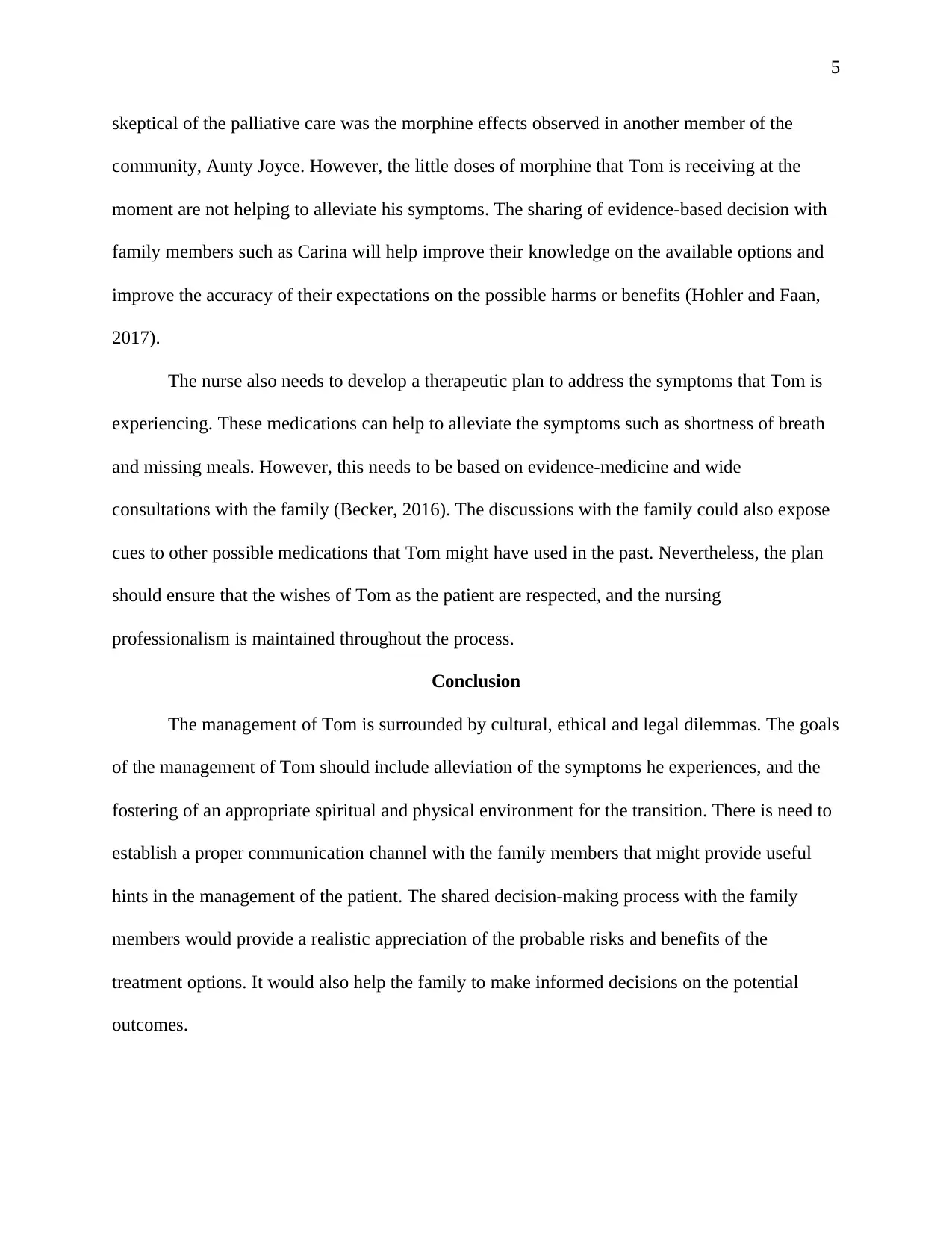
5
skeptical of the palliative care was the morphine effects observed in another member of the
community, Aunty Joyce. However, the little doses of morphine that Tom is receiving at the
moment are not helping to alleviate his symptoms. The sharing of evidence-based decision with
family members such as Carina will help improve their knowledge on the available options and
improve the accuracy of their expectations on the possible harms or benefits (Hohler and Faan,
2017).
The nurse also needs to develop a therapeutic plan to address the symptoms that Tom is
experiencing. These medications can help to alleviate the symptoms such as shortness of breath
and missing meals. However, this needs to be based on evidence-medicine and wide
consultations with the family (Becker, 2016). The discussions with the family could also expose
cues to other possible medications that Tom might have used in the past. Nevertheless, the plan
should ensure that the wishes of Tom as the patient are respected, and the nursing
professionalism is maintained throughout the process.
Conclusion
The management of Tom is surrounded by cultural, ethical and legal dilemmas. The goals
of the management of Tom should include alleviation of the symptoms he experiences, and the
fostering of an appropriate spiritual and physical environment for the transition. There is need to
establish a proper communication channel with the family members that might provide useful
hints in the management of the patient. The shared decision-making process with the family
members would provide a realistic appreciation of the probable risks and benefits of the
treatment options. It would also help the family to make informed decisions on the potential
outcomes.
skeptical of the palliative care was the morphine effects observed in another member of the
community, Aunty Joyce. However, the little doses of morphine that Tom is receiving at the
moment are not helping to alleviate his symptoms. The sharing of evidence-based decision with
family members such as Carina will help improve their knowledge on the available options and
improve the accuracy of their expectations on the possible harms or benefits (Hohler and Faan,
2017).
The nurse also needs to develop a therapeutic plan to address the symptoms that Tom is
experiencing. These medications can help to alleviate the symptoms such as shortness of breath
and missing meals. However, this needs to be based on evidence-medicine and wide
consultations with the family (Becker, 2016). The discussions with the family could also expose
cues to other possible medications that Tom might have used in the past. Nevertheless, the plan
should ensure that the wishes of Tom as the patient are respected, and the nursing
professionalism is maintained throughout the process.
Conclusion
The management of Tom is surrounded by cultural, ethical and legal dilemmas. The goals
of the management of Tom should include alleviation of the symptoms he experiences, and the
fostering of an appropriate spiritual and physical environment for the transition. There is need to
establish a proper communication channel with the family members that might provide useful
hints in the management of the patient. The shared decision-making process with the family
members would provide a realistic appreciation of the probable risks and benefits of the
treatment options. It would also help the family to make informed decisions on the potential
outcomes.
⊘ This is a preview!⊘
Do you want full access?
Subscribe today to unlock all pages.

Trusted by 1+ million students worldwide
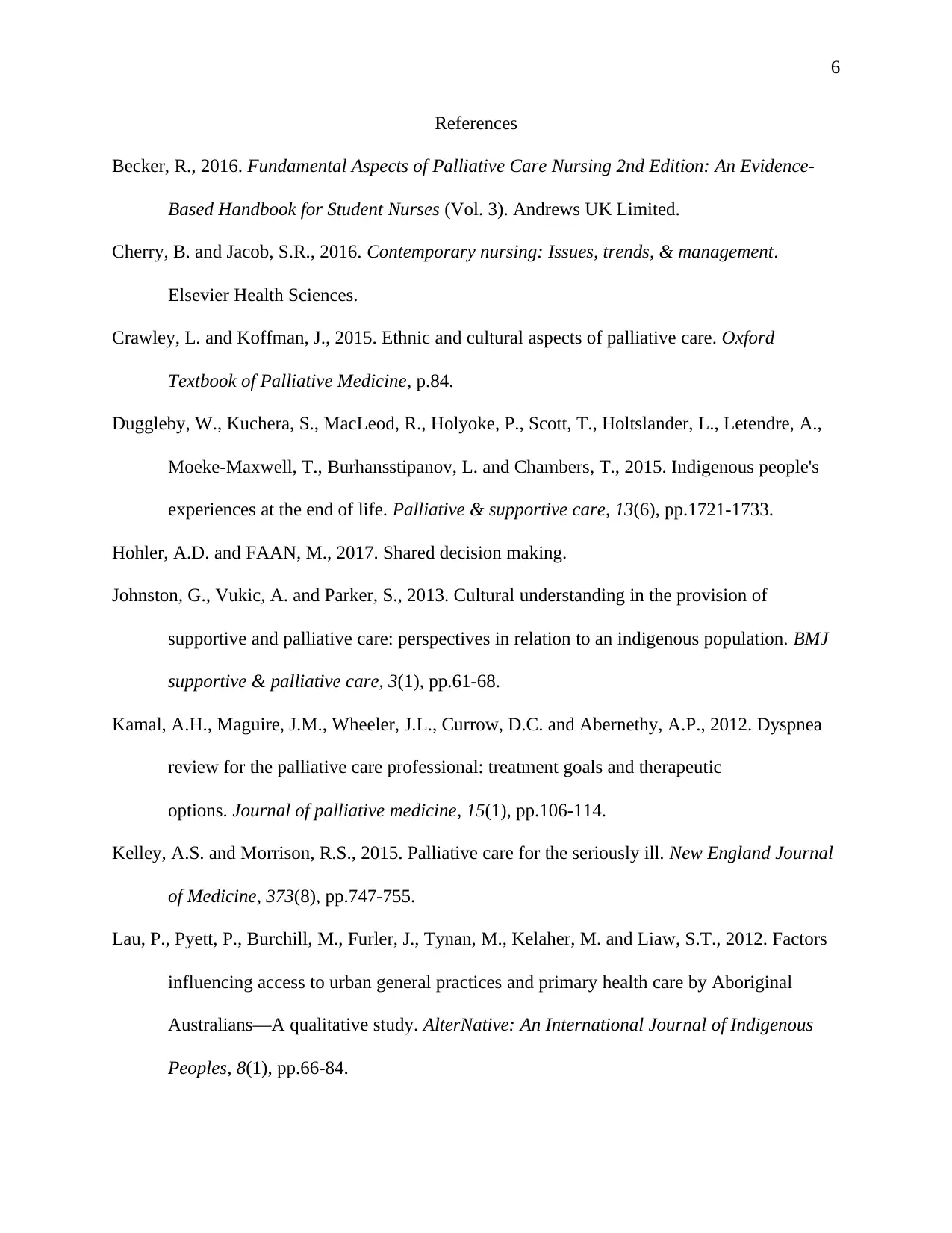
6
References
Becker, R., 2016. Fundamental Aspects of Palliative Care Nursing 2nd Edition: An Evidence-
Based Handbook for Student Nurses (Vol. 3). Andrews UK Limited.
Cherry, B. and Jacob, S.R., 2016. Contemporary nursing: Issues, trends, & management.
Elsevier Health Sciences.
Crawley, L. and Koffman, J., 2015. Ethnic and cultural aspects of palliative care. Oxford
Textbook of Palliative Medicine, p.84.
Duggleby, W., Kuchera, S., MacLeod, R., Holyoke, P., Scott, T., Holtslander, L., Letendre, A.,
Moeke-Maxwell, T., Burhansstipanov, L. and Chambers, T., 2015. Indigenous people's
experiences at the end of life. Palliative & supportive care, 13(6), pp.1721-1733.
Hohler, A.D. and FAAN, M., 2017. Shared decision making.
Johnston, G., Vukic, A. and Parker, S., 2013. Cultural understanding in the provision of
supportive and palliative care: perspectives in relation to an indigenous population. BMJ
supportive & palliative care, 3(1), pp.61-68.
Kamal, A.H., Maguire, J.M., Wheeler, J.L., Currow, D.C. and Abernethy, A.P., 2012. Dyspnea
review for the palliative care professional: treatment goals and therapeutic
options. Journal of palliative medicine, 15(1), pp.106-114.
Kelley, A.S. and Morrison, R.S., 2015. Palliative care for the seriously ill. New England Journal
of Medicine, 373(8), pp.747-755.
Lau, P., Pyett, P., Burchill, M., Furler, J., Tynan, M., Kelaher, M. and Liaw, S.T., 2012. Factors
influencing access to urban general practices and primary health care by Aboriginal
Australians—A qualitative study. AlterNative: An International Journal of Indigenous
Peoples, 8(1), pp.66-84.
References
Becker, R., 2016. Fundamental Aspects of Palliative Care Nursing 2nd Edition: An Evidence-
Based Handbook for Student Nurses (Vol. 3). Andrews UK Limited.
Cherry, B. and Jacob, S.R., 2016. Contemporary nursing: Issues, trends, & management.
Elsevier Health Sciences.
Crawley, L. and Koffman, J., 2015. Ethnic and cultural aspects of palliative care. Oxford
Textbook of Palliative Medicine, p.84.
Duggleby, W., Kuchera, S., MacLeod, R., Holyoke, P., Scott, T., Holtslander, L., Letendre, A.,
Moeke-Maxwell, T., Burhansstipanov, L. and Chambers, T., 2015. Indigenous people's
experiences at the end of life. Palliative & supportive care, 13(6), pp.1721-1733.
Hohler, A.D. and FAAN, M., 2017. Shared decision making.
Johnston, G., Vukic, A. and Parker, S., 2013. Cultural understanding in the provision of
supportive and palliative care: perspectives in relation to an indigenous population. BMJ
supportive & palliative care, 3(1), pp.61-68.
Kamal, A.H., Maguire, J.M., Wheeler, J.L., Currow, D.C. and Abernethy, A.P., 2012. Dyspnea
review for the palliative care professional: treatment goals and therapeutic
options. Journal of palliative medicine, 15(1), pp.106-114.
Kelley, A.S. and Morrison, R.S., 2015. Palliative care for the seriously ill. New England Journal
of Medicine, 373(8), pp.747-755.
Lau, P., Pyett, P., Burchill, M., Furler, J., Tynan, M., Kelaher, M. and Liaw, S.T., 2012. Factors
influencing access to urban general practices and primary health care by Aboriginal
Australians—A qualitative study. AlterNative: An International Journal of Indigenous
Peoples, 8(1), pp.66-84.
Paraphrase This Document
Need a fresh take? Get an instant paraphrase of this document with our AI Paraphraser
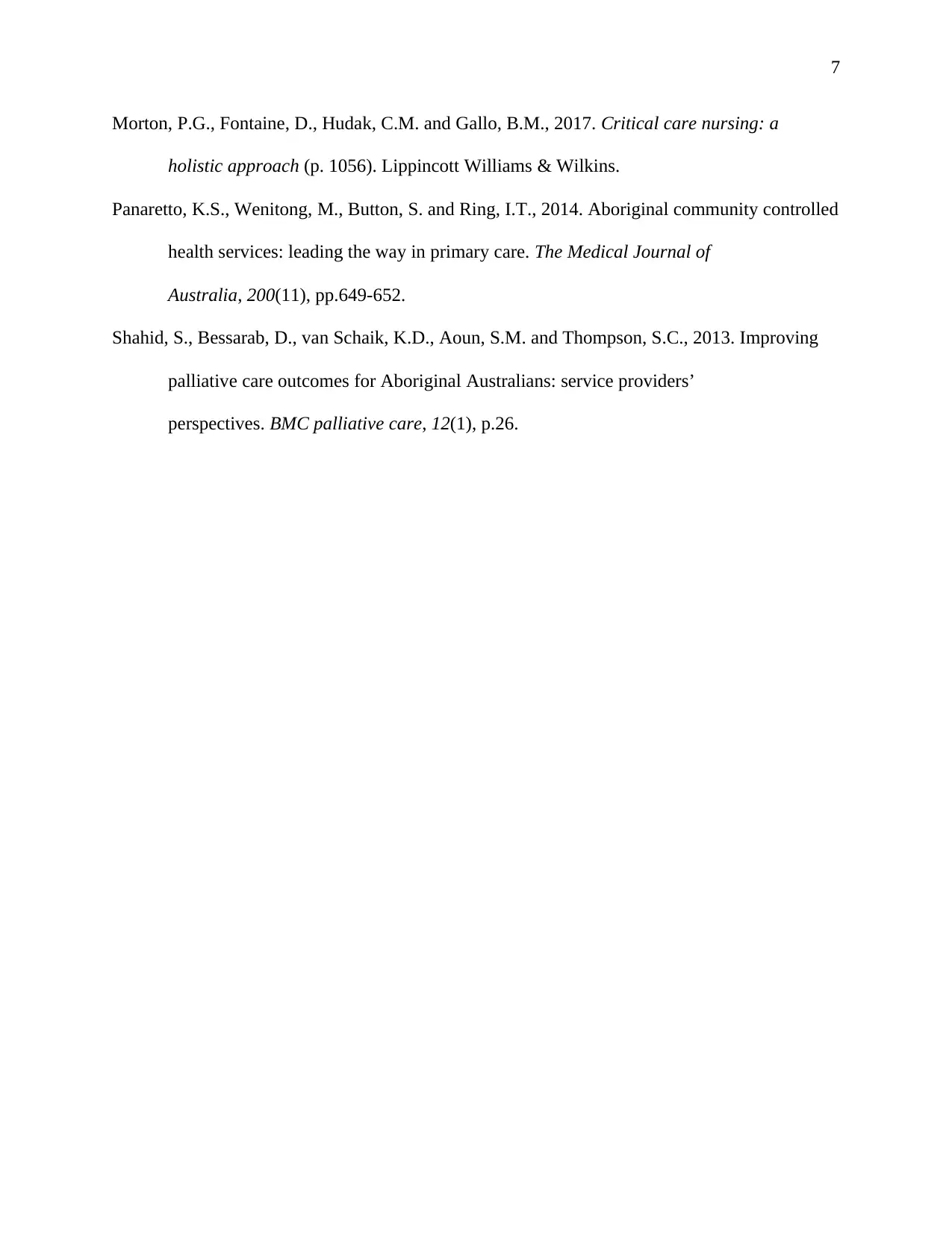
7
Morton, P.G., Fontaine, D., Hudak, C.M. and Gallo, B.M., 2017. Critical care nursing: a
holistic approach (p. 1056). Lippincott Williams & Wilkins.
Panaretto, K.S., Wenitong, M., Button, S. and Ring, I.T., 2014. Aboriginal community controlled
health services: leading the way in primary care. The Medical Journal of
Australia, 200(11), pp.649-652.
Shahid, S., Bessarab, D., van Schaik, K.D., Aoun, S.M. and Thompson, S.C., 2013. Improving
palliative care outcomes for Aboriginal Australians: service providers’
perspectives. BMC palliative care, 12(1), p.26.
Morton, P.G., Fontaine, D., Hudak, C.M. and Gallo, B.M., 2017. Critical care nursing: a
holistic approach (p. 1056). Lippincott Williams & Wilkins.
Panaretto, K.S., Wenitong, M., Button, S. and Ring, I.T., 2014. Aboriginal community controlled
health services: leading the way in primary care. The Medical Journal of
Australia, 200(11), pp.649-652.
Shahid, S., Bessarab, D., van Schaik, K.D., Aoun, S.M. and Thompson, S.C., 2013. Improving
palliative care outcomes for Aboriginal Australians: service providers’
perspectives. BMC palliative care, 12(1), p.26.
1 out of 8
Related Documents
Your All-in-One AI-Powered Toolkit for Academic Success.
+13062052269
info@desklib.com
Available 24*7 on WhatsApp / Email
![[object Object]](/_next/static/media/star-bottom.7253800d.svg)
Unlock your academic potential
Copyright © 2020–2025 A2Z Services. All Rights Reserved. Developed and managed by ZUCOL.





